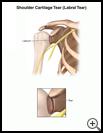
Shoulder Cartilage Tear (Labral Tear)
________________________________________________________________________
KEY POINTS
- A shoulder cartilage tear is a tear in the tissue around the socket, or cup, of the shoulder joint.
- You will need to change or stop doing the activities that cause pain until your shoulder has healed.
- Treatment may include stretching and strengthening exercises and wearing a sling. If you have a bad tear, you may need to have surgery.
- Doing exercises to strengthen the muscles around your shoulder may help prevent injury.
________________________________________________________________________
What is a shoulder cartilage tear?
Your shoulder is a ball-and-socket joint. A shoulder cartilage tear is a tear in the tissue around the socket, or cup, of the shoulder joint. The socket of the shoulder blade holds the ball-shaped end of the upper arm bone.
The tissue around the shoulder joint is called the labrum. Another term for this injury is labral tear.
What is the cause?
The labrum can be torn by an activity that causes the bones in your shoulder joint to move out of place so that the joint no longer works properly. For example, it might happen from:
- Falling onto your arm or using your arm to break a fall
- A sharp pull on your arm or shoulder, which might happen, for example, when you hold onto something as you fall
- Lifting a heavy object
- Using your shoulder in sports with repeated, high-speed, overhead movements, like throwing a ball or serving in tennis
What are the symptoms?
Symptoms may include:
- Pain in the arm and shoulder
- Weakness of the arm and shoulder
- Pain when you make overhead movements of your shoulder
- Clicking or grinding sounds or feelings when you move your shoulder
How is it diagnosed?
Your healthcare provider will ask about your symptoms and how the injury happened. Your provider will examine you. Tests may include:
- X-rays of the shoulder
- MRI, which uses a strong magnetic field and radio waves to show detailed pictures of the shoulder
- Arthrogram, which uses a dye injected into the shoulder to give a better look at the shoulder structures
- Arthroscopy, which is a type of surgery done with a small scope inserted into your shoulder so your provider can look directly at your shoulder
How is it treated?
Treatment depends on how bad the tear is.
- You will need to change or stop doing the activities that cause pain until your shoulder has healed.
- Your healthcare provider may recommend stretching and strengthening exercises to help you heal.
- You may need to wear a sling to prevent pain.
- If you have a bad tear, you may need to have surgery. The tear may be repaired or the torn parts trimmed away. If you have scar tissue, it may be removed. If you have torn the labrum, it may be reattached.
Pain from a labral tear may last a long time. The pain may go away but then come back again with certain movements of the shoulder. You may keep having symptoms until the torn labrum is fixed with surgery.
How can I take care of myself?
To help keep swelling down and relieve pain:
- Put an ice pack, gel pack, or package of frozen vegetables wrapped in a cloth on the area every 3 to 4 hours for up to 20 minutes at a time.
- Take nonprescription pain medicine, such as acetaminophen, ibuprofen, or naproxen. Read the label and take as directed. Unless recommended by your healthcare provider, you should not take these medicines for more than 10 days.
- Nonsteroidal anti-inflammatory medicines (NSAIDs), such as ibuprofen, naproxen, and aspirin, may cause stomach bleeding and other problems. These risks increase with age.
- Acetaminophen may cause liver damage or other problems. Unless recommended by your provider, don't take more than 3000 milligrams (mg) in 24 hours. To make sure you don’t take too much, check other medicines you take to see if they also contain acetaminophen. Ask your provider if you need to avoid drinking alcohol while taking this medicine.
Moist heat may help relax your muscles and make it easier to move your arm and shoulder. Put moist heat on the injured area for 10 to 15 minutes at a time before you do warm-up and stretching exercises. Moist heat includes heat patches or moist heating pads that you can purchase at most drugstores, a wet washcloth or towel that has been heated in a microwave or the dryer, or a hot shower. Don’t use heat if you have swelling.
Follow your healthcare provider's instructions, including any exercises recommended by your provider. Ask your provider:
- How and when you will get your test results
- How long it will take to recover
- If there are activities you should avoid, including how much you can lift, and when you can return to your normal activities
- How to take care of yourself at home
- What symptoms or problems you should watch for and what to do if you have them
Make sure you know when you should come back for a checkup.
How can I help prevent a labral tear?
Many labral tears are caused by accidents that are not easy to prevent. Using good form while throwing, playing racquet sports, or lifting heavy objects may help prevent injury. Follow safety rules and use any protective equipment recommended for your work or sport. Warm-up exercises and stretching before activities and doing exercises to strengthen the muscles around your shoulder can help prevent injury.
If your arm or shoulder hurts after exercise, putting ice on it may help keep it from getting injured.

